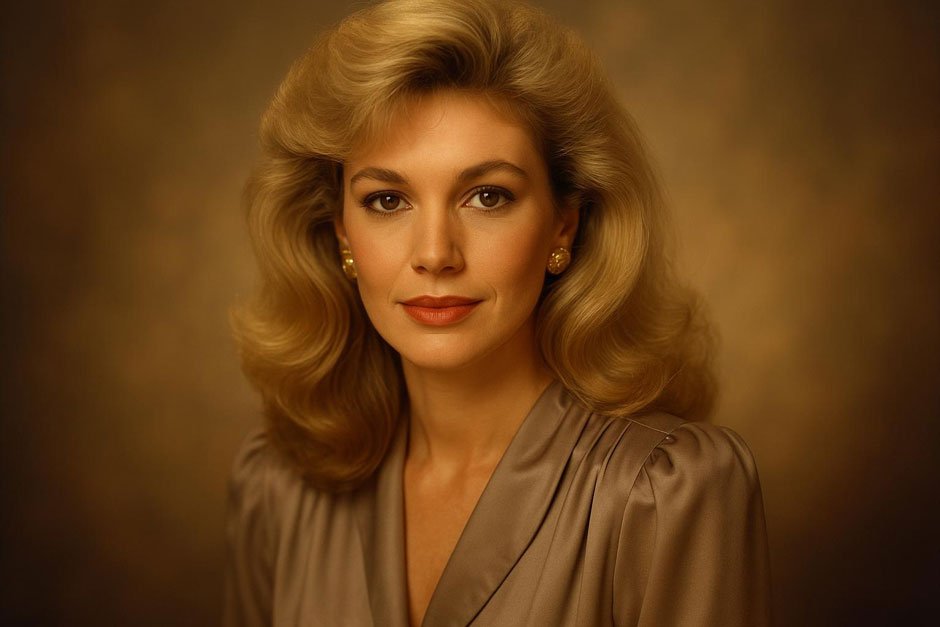Introduction
Back in the electric atmosphere of the 1980s, when shoulder pads ruled fashion and neon lights painted the night, Lyn Barron stepped into the spotlight as one of Australia’s most intriguing entertainment figures. This Sydney-born actress and model didn’t just make waves in her homeland – she crossed oceans to leave her mark on Hollywood’s golden era.
What made Barron particularly fascinating wasn’t just her on-screen presence, but her real-life romance with Christopher Atkins, the heartthrob who had captured millions of hearts in “The Blue Lagoon.” Their love story became the stuff of tabloid dreams, spanning over two decades of marriage and family life.
From modeling shoots in Australia to red carpet events in Los Angeles, Barron’s journey reads like a script from the very films she appeared in. Her story interweaves professional ambition with personal drama, creating a narrative that entertainment fans still discuss today.
Early Life and Australian Roots
Sydney in the 1960s and 70s was a city coming into its own, and Lyn Barron grew up right in the heart of this cultural awakening. The harbor city’s stunning backdrop and vibrant arts scene provided the perfect environment for a future entertainer to develop her talents.
While specific details about her childhood remain carefully guarded, those who knew her during these formative years remember a young woman with natural charisma and an eye for opportunity. Australia’s entertainment industry was experiencing its own renaissance during this period, creating pathways for local talent to gain international recognition.
The confidence that would later serve her well in Hollywood boardrooms and on movie sets was already evident during her teenage years. Friends recall her infectious laugh and natural ability to command attention in any room she entered.
Modeling Career and Playboy Fame
Lyn Barron’s modeling career began to flourish just as Australia was establishing itself as a serious player in the international fashion world. Her distinctive look – a perfect blend of girl-next-door charm and sophisticated elegance – made her a favorite among photographers and casting directors.
The opportunity to work with Playboy represented a significant milestone in her career. This wasn’t just another modeling gig; it was a chance to join an exclusive group of women who had achieved international recognition through the iconic magazine. The experience taught her valuable lessons about branding and image management that would prove invaluable later.
Her Playboy centerfold work opened doors across multiple continents. Suddenly, casting directors in Los Angeles and New York knew her name, and opportunities began flowing in from unexpected directions. The exposure also connected her with influential figures in television and film production.
However, this success came with its own set of challenges. Navigating the expectations and stereotypes associated with Playboy modeling required both thick skin and strategic thinking. Barron handled these pressures with grace, using the platform as a stepping stone rather than a final destination.
Acting Career and Film Appearances
When Lyn Barron decided to transition from modeling to acting, she brought the same determination that had made her successful in front of the camera as a model. Her debut in “Death Games” (1980) marked her entry into the film world during one of cinema’s most experimental periods.
The thriller showcased her ability to hold her own alongside more experienced actors. Critics noted her natural screen presence and her willingness to fully commit to her character, qualities that would become her trademark in subsequent performances.
“Centrespread” (1981) provided Barron with her most memorable role as a Beach Girl. The film captured the carefree spirit of early 1980s youth culture, and her performance embodied the optimism and energy of the era. Her scenes crackled with authenticity, suggesting someone who truly understood the character she was portraying.
Though her filmography remained compact, both movies demonstrated her range as a performer. She could handle dramatic tension in “Death Games” and bring lighthearted charm to “Centrespread,” proving her versatility as an actress. Industry insiders began taking notice of this Australian talent who seemed equally comfortable in different genres.
Meeting Christopher Atkins: A Star-Crossed Romance
Destiny has a funny way of bringing people together, and for Lyn Barron, it arrived in 1984 wearing the face of Christopher Atkins. The American actor had traveled to Australia to film a project for the Playboy channel, riding the wave of success that followed his breakout role in “The Blue Lagoon.”
Atkins was at the peak of his fame when their paths crossed. His portrayal of Richard Lestrange had made him a global heartthrob, and his presence in Australia created quite a stir among local entertainment circles. Yet when he met Barron, something shifted in his typically guarded demeanor.
The attraction was instantaneous and mutual. Here was an Australian model-actress who could match his wit, share his passion for the entertainment industry, and understand the unique pressures of life in the public eye. Their conversations flowed effortlessly, covering everything from career aspirations to personal dreams.
What started as a professional acquaintance quickly blossomed into something deeper. Within weeks, they were inseparable, exploring Sydney together and discovering they shared similar values about family and relationships. The entertainment press couldn’t get enough of this international romance.
Their six-month courtship felt both whirlwind and inevitable. Friends from both sides of the Pacific watched as two people who seemed perfectly matched found each other across continents and cultures.
Marriage and Family Life
The wedding bells rang on May 25, 1985, as Lyn Barron and Christopher Atkins said their vows at the Rye Presbyterian Church in New York. The ceremony was elegant yet intimate, reflecting the couple’s desire to balance their public personas with private moments of genuine emotion.
Their reception at the Apawamis Club became the social event of the season. Entertainment industry luminaries mingled with family members, creating an atmosphere that perfectly captured the glamour of mid-1980s celebrity culture. The newlyweds looked radiant, clearly thrilled to be starting this new chapter together.
Los Angeles became their home base, a decision that made practical sense for Atkins’ career while offering Barron new opportunities in American entertainment. The transition from Sydney to Hollywood represented a major life change, but she approached it with characteristic enthusiasm and adaptability.
Grant Bomann arrived on December 10, 1985, transforming the couple into a family of three. The timing was perfect – both parents were established enough in their careers to focus on parenthood while still young enough to fully enjoy the experience. Brittney Bomann joined the family on May 1, 1987, completing their domestic picture.
Balancing celebrity status with family life required constant negotiation. The couple worked hard to provide their children with as normal an upbringing as possible while acknowledging the unique circumstances of their parents’ careers. Family vacations often became media events, but they learned to carve out private time away from cameras and reporters.
Life After Divorce and Legacy
After 22 years of marriage, Lyn Barron and Christopher Atkins made the difficult decision to divorce in 2007. The end of their relationship marked the conclusion of one of Hollywood’s more enduring celebrity marriages, surprising fans who had followed their journey from the beginning.
The post-divorce period saw Barron choosing a quieter path, focusing her energy on her role as mother to Grant and Brittney, both now adults pursuing their own dreams. This decision to step back from public life demonstrated her priorities and her desire to maintain some privacy after decades in the spotlight.
Her various names throughout different life phases tell their own story. Lyn Barron, Lynne Barron, Lynne Barron Bomann, Lyn Bomann – each represents a different chapter in her personal evolution. From Australian model to Hollywood wife to independent woman, these names mark the milestones of a life fully lived.
The impact of her relationship with Christopher Atkins extends beyond their personal story. Together, they represented a type of celebrity couple that defined 1980s entertainment culture – glamorous, international, and seemingly perfect. Their longevity in an industry known for brief relationships made them role models for other celebrity couples.
Even today, entertainment historians point to their relationship as an example of how celebrity marriages could work when both partners maintained their individual identities while building something together. Their approach to balancing public and private life influenced how other celebrity couples would handle similar challenges.
Conclusion
Looking back at Lyn Barron’s remarkable journey, it’s clear that her story represents much more than a simple tale of fame and fortune. Her path from Sydney model to Hollywood actress to devoted mother illustrates the complex realities of life in the entertainment industry during one of its most glamorous eras.
Her brief but memorable acting career demonstrated that talent and determination could open doors across international boundaries. The films she appeared in may not have been blockbusters, but they captured the spirit of their time and showcased her natural abilities as a performer.
The 22-year marriage to Christopher Atkins stands as a testament to the possibility of lasting love in an industry where relationships often crumble under pressure. Their partnership weathered the storms of celebrity life while producing two children who have grown into accomplished adults.
Perhaps most importantly, Lyn Barron’s story reminds us that behind every celebrity narrative lies a real person making difficult choices about career, family, and personal fulfillment. Her decision to prioritize privacy in later years shows wisdom gained through experience.
Her Australian heritage, combined with her adaptability to American culture, created a unique perspective that enriched everything she touched. From modeling shoots to movie sets to family gatherings, she brought authenticity and warmth that people remembered long after the cameras stopped rolling.
Today, as new generations discover the entertainment treasures of the 1980s, Lyn Barron’s contributions continue to resonate. Her story serves as both inspiration and cautionary tale, showing how talent, timing, and personal choices can shape a life in ways both expected and surprising.









